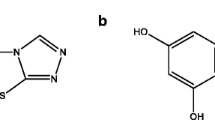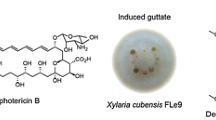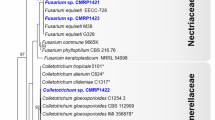Abstract
Lawsone (2-hydroxy-1, 4-napthoquinone), also known as hennotannic acid, is an orange red dye used as a popular skin and hair colorant. The dye is produced in the leaves of Lawsonia inermis L, often referred to as the “henna” tree. In this study, we report the production of lawsone by an endophytic fungus, Gibberella moniliformis isolated from the leaf tissues of Lawsonia inermis. The fungus produced the orange-red dye in potato dextrose agar and broth, independent of the host tissue. Presence of lawsone was confirmed spectrometrically using HPLC and ESI–MS/MS analysis. The fragmentation pattern of lawsone was identical to both standard lawsone and that extracted from plant tissue. This is a first report of lawsone being produced by an endophytic fungus, independent of the host tissue. The study opens up interesting questions on the possible biosynthetic pathway through which lawsone is produced by the fungus.





Similar content being viewed by others
References
Anju D, Kavita S, Jugnu G, Munish G, Asha S (2012) Determination of lawsone content in fresh and dried leaves of Lawsonia inermis Linn. and its quantitative analysis by HPTLC. J Pharma Sci Innov 1:17–20
Arx JV (1981) The genera of fungi sporulating in pure culture. J. Cramer, Lehre
Babula P, Adam V, Havel L, Kizek R (2009) Noteworthy secondary metabolites naphthoquinones-their occurrence, pharmacological properties and analysis. Curr Pharm Anal 5:47–68
Bandara WMMS, Seneviratne G, Kulasooriya SA (2006) Interactions among endophytic bacteria and fungi: effects and potentials. J Bio Sci 31:645–650
Bohm BA (1967) Naphthoquinone biosynthesis in higher plants: II p-hydroxybenzoic acid as a precursor of 2-hydroxy 1, 4-naphthoquinone in Impatiens balsamina L. Biochem Biophys Res Commun 26:621–624
Brahmeshwari G, Surekha M, Saini K (2012) Antifungal activity of naphthothiazoles derived from Lawsone (Lawsonia inermis). Afr J Biotechnol 11:14405–14409
Cui Y, Yi D, Bai X, Sun B, Zhao Y, Zhang Y (2012) Ginkgolide B produced endophytic fungus (Fusarium oxysporum) isolated from Ginkgo biloba. Fitoterapia 83:913–920
Dass K, Mariappan P (2014) Larvicidal activity of Lawsonia inermis and Murraya exotica leaves extract on filarial vector, Culex quinquefasciatus. Int J Mosq Res 1:25–27
De Carvalho CR, Vieira MDLA, Cantrell CL, Wedge DE, Alves TM, Zani CL, Pimenta RS, Sales Junior PA, Murta SM, Romanha AJ, Rosa CA (2016) Biological activities of ophiobolin K and 6-epi-ophiobolin K produced by the endophytic fungus Aspergillus calidoustus. Nat Prod Res 30:478–481
Domsch KH, Gams W, Anderson TH (1980) Compendium of soil fungi, vol 1. Academic Press Ltd., London
Dongsheng L, Yudong C, Jinping W, Wenjin L (2009) Identification of H8 strain of endophytic fungi from a tea plant and its culture conditions for producing red pigment. J Northeast For Univ 9:037
EI-Shaer NS, Badr JM, Aboul-Ela MA, Gohar YM (2007) Determination of lawsone in henna powders by high performance thin layer chromatography. J Sep Sci 30:3311–3315
El-Hawary SS, Mohammed R, Abouzid SF, Bakeer W, Ebel R, Sayed AM, Rateb ME (2016) Solamargine production by a fungal endophyte of Solanum nigrum. J Appl Microbiol 120:900–911
Ellis MB, Ellis JP (1985) Microfungi on land plants. An identification handbook. Croom Helm Ltd, London
Fernandez C, Monnier Y, Santonja M, Gallet C, Weston LA, Prévosto B, Saunier A, Baldy V, Bousquet-Mélou A (2016) The impact of competition and allelopathy on the trade-off between plant defense and growth in two contrasting tree species. Front Plant Sci 7:594
Fisher PJ, Petrini O (1987) Location of fungal endophytes in tissues of Sueda fruictcosa: a preliminary study. Trans Br Mycol Soc 89:246–249
Folk TL, Singh H, Scheuer PJ (1973) Mass spectra of derivatives of 5-hydroxy-1, 4-naphthoquinone (juglone). J Chem Soc Perkin Trans 2:1781–1784
Gan Y, Zhang Y, Li A, Song C, Chen C, Xu Y, Ruan H, Jiang H (2015) A novel four-step approach for systematic identification of naphthoquinones in Juglans cathayensis dode using various scan functions of liquid chromatography-tandem mass spectrometry along with data mining strategies. Phytochem Anal 26:413–422
Goswami M, Kulshreshtha M, Rao CV, Yadav S, Yadav S (2011) Anti-ulcer potential of Lawsonia inermis L. leaves against gastric ulcers in rats. J Appl Pharm Sci 1:69
Gouda S, Das G, Sen SK, Shin HS, Patra JK (2016) Endophytes: a treasure house of bioactive compounds of medicinal importance. Front Microbiol 7:1538
Heo JY, Cho CH, Jeon HS, Cheong BS, Cho HG (2011) Enhanced Raman spectrum of lawsone on Ag surface: vibrational analyses, frequency shifts, and molecular geometry. Spectrochim Acta Mol Biomol Spectrosc 83:425–431
Higgins KL, Arnold AE, Miadlikowska J, Sarvate SD, Lutzoni F (2007) Phylogenetic relationships, host affinity, and geographic structure of boreal and arctic endophytes from three major plant lineages. Mol Phylogenet Evol 42:543–555
Huang WL, Fan XJ, Yan ZY, Ma YT, Meng XL (2012) Diversity study of arbuscular mycorrhizal fungi of Coptis deltoidea. J Chin Med Mater 35:689–693
Ikeda Y, Komura M, Watanabe M, Minami C, Koike H, Itoh S, Kashino Y, Satoh K (2008) Photosystem I complexes associated with fucoxanthin-chlorophyll-binding proteins from a marine centric diatom, Chaetoceros gracilis. Biochim Biophys Acta 1777:351–361
Jia M, Ming QL, Zhang Q, Chen Y, Cheng N, Wu WW, Han T, Qin LP (2014) Gibberella moniliformis AH13 with antitumor activity, an endophytic fungus strain producing triolein isolated from adlay (Coix lacryma-jobi: Poaceae). Curr Microbiol 69:381–387
Jiang Y, Li HB, Chen F, Hyde KD (2005) Production potential of water-soluble Monascus red pigment by a newly isolated Penicillium sp. J AgricTechnol 1:113–126
Khanam B, Chandra R (2015) Isolation and identification of endophytic bacteria producing bright red pigment from the dye yielding plant Beta vulgaris.L. Int J Pharma Pharm Sci 7:220–224
Koetschan C, Forster F, Keller A, Schleicher T, Ruderisch B, Schultz J (2010) The ITS2 Database III—sequences and structures for phylogeny. Nucleic Acids Res 38:D275–D279
Krishnamurthy KV, Siva R, Senthi TK (2002) The natural dye yielding plants of Shervaroy hills of Eastern Ghats. In: Proceedings of national seminar on the conservation of Eastern Ghats. pp 151–153
Kumara MP, Zuehlke S, Priti V, Ramesha BT, Shweta S, Ravikanth G, Vasudeva R, Santhoshkumar TR, Spiteller M, Uma Shaanker R (2012) Fusarium proliferatum, an endophytic fungus from Dysoxylum binectariferum Hook.f, produces rohitukine, a chromane alkaloid possessing anti-cancer activity. Antonie Van Leeuwenhoek 101:323–329
Kumara MP, Soujanya KN, Ravikanth G, Vasudeva R, Ganeshaiah KN, Uma Shaanker R (2014) Rohitukine, a chromone alkaloid and a precursor of flavopiridol, is produced by endophytic fungi isolated from Dysoxylum binectariferum Hook.f and Amoora rohituka (Roxb). Wight & Arn. Phytomedicine 21:541–546
Kushwaha D, Saha S, Dutta S (2014) Enhanced biomass recovery during phyco remediation of Cr(VI) using cyanobacteria and prospect of biofuel production. Ind Eng Chem Res 53:19754–19764
Maeda H, Dudareva N (2012) The shikimate pathway and aromatic amino acid biosynthesis in plants. Annu Rev Plant Biol 63:73–105
Mahal K, Ahmad A, Schmitt F, Lockhauserbäumer J, Starz K, Pradhan R, Padhye S, Sarkar FH, Koko WS, Schobert R, Ersfeld K (2017) Improved anticancer and antiparasitic activity of new lawsone Mannich bases. Eur J Med Chem 126:421–431
Müller WU, Leistner E (1976) 1, 4-Naphthoquinone, an intermediate in juglone (5- hydroxy-1, 4-naphthoquinone) biosynthesis. Phytochemistry 15:407–410
Nair DN, Padmavathy S (2014) Impact of endophytic microorganisms on plants environment and human. Sci World J. doi:10.1155/2014/250693
Parthasarathy R, Sathiyabama M (2014) Gymnemagenin-producing endophytic fungus isolated from a medicinal plant Gymnema sylvestre R. Br. Appl Biochem Biotechnol 172:3141–3152
Patil SV, Patil CD, Salunkhe RB, Salunke BK (2010) Larvicidal activities of six plants extracts against two mosquito species, Aedes aegypti and Anopheles stephensi. Trop Biomed 27:360–365
Priti V, Ramesha BT, Shweta S, Ravikanth G, Ganeshaiah KN, Suryanarayanan TS, Uma Shaanker R (2009) How promising are endophytic fungi as alternative sources of plant secondary metabolites? Curr Sci 97:477–478
Rohrbacher F, St-Arnaud M (2016) Root exudation: the ecological driver of hydrocarbon rhizoremediation. Agronomy 6:19
Sachin N, Manjunatha BL, Kumara PM, Ravikanth G, Shweta S, Suryanarayanan TS, Ganeshaiah KN, Uma Shaanker R (2013) Do endophytic fungi possess pathway genes for plant secondary metabolites? Curr Sci 104:178–182
Sharma KK, Saikia R, Kotoky J, Kalita JC, Devi R (2011) Antifungal activity of Solanum melongena L. Lawsonia inermis L. and Justicia gendarussa B. against Dermatophytes. Int J PharmTech Res 3:1635–1640
Shintani A, Yamazaki H, Yamamoto Y, Ahmed F, Ishibashi M (2009) Cribrarione C, a Naphthoquinone Pigment from the Myxomycete Cribraria meylanii. Biol Pharm Bull 57:894–895
Shweta S, Zuehlke S, Ramesha BT, Priti V, Kumar PM, Ravikanth G, Spiteller M, Vasudeva R, Shaanker RU (2010) Endophytic fungal strains of Fusarium solani, from Apodytes dimidiata E. Mey.ex Arn (Icacinaceae) produce camptothecin, 10-hydroxycamptothecin and 9-methoxycamptothecin. Phytochemistry 71:117–122
Shweta S, Bindu JH, Raghu J, Suma HK, Manjunatha BL, Kumara PM, Ravikanth G, Nataraj KN, Ganeshaiah KN, Uma Shaanker R (2013a) Isolation of endophytic bacteria producing the anti-cancer alkaloid camptothecine from Miquelia dentata Bedd. (Icacinaceae). Phytomedicine 20:913–917
Shweta S, Gurumurthy BR, Ravikanth G, Uma Shaanker R, Shivanna MB (2013b) Endophytic fungi from Miquelia dentata Bedd., produce the anti-cancer alkaloid, camptothecine. Phytomedicine 20:337–342
Shweta S, Shivanna MB, Gurumurthy BR, Shaanker U, Santhosh Kumar TR, Ravikanth G (2014) Inhibition of fungal endophytes by camptothecine produced by their host plant, Nothapodytes nimmoniana (Grahm) Mabb. (Icacinaceae). Curr Sci 107:994–1000
Siva R (2003) Assessment of Genetic Variations in Some dye yielding plants using Isozyme data. Ph.D. thesis submitted to the Bharathidasan University, Tiruchirappalli, India
Siva R (2007) Status of natural dyes and dye-yielding plants in India. Curr Sci 92:916–925
Siva R, Subha K, Bhakta D, Ghosh AR, Babu S (2012) Characterization and enhanced production of prodigiosin from the spoiled coconut. Appl Biochem Biotechnol 166:187–196
Studt L, Wiemann P, Kleigrewe K, Humpf HU, Tudzynski B (2012) Biosynthesis of fusarubins accounts for pigmentation of Fusarium fujikuroi perithecia. Appl Environ Microbiol 78:4468–4480
Suman TY, Elumalai D, Vignesh A, Kaleena PK, Murugesan K (2012) Evaluation of larvicidal activity of the aerial extracts of a medicinal plant, Ammannia baccifera (Linn) against two important species of mosquitoes, Aedes aegypti and Culex quinquefasciatus. Asian Pac J Trop Dis 2:352–355
Sutton BC (1980) The Coelomycetes: fungi imperfecti with pycnidia acervuli and stromata, Commonwealth Mycological Institute 696
Tan RX, Zou WX (2001) Endophytes: a rich source of functional metabolites. Nat Prod Rep 18:448–459
Taylor JE, Hyde KD, Jones EBG (1999) Endophytic fungi associated with the temperate palm, Trachycarpus fortunei, within and outside its natural geographic range. New Phytol 142:335–346
Vainio EJ, Korhonen K, Hantula J (1998) Genetic variation in Phlebiopsis gigsntea as detected with random amplified microsatellite(RAMS)markers. Mycol Res 102:187–192
Vasanthakumari MM, Jadhav SS, Sachin N, Vinod G, Shweta S, Manjunatha BL, Mohana PK, Ravikanth G, Nataraja NK, Uma Shaanker R (2015) Restoration of camptothecine production in attenuated endophytic fungus on re-inoculation into host plant and treatment with DNA methyltransferase inhibitor. World J Microbiol Biotechnol 31:1629–1639
Venugopalan A, Srivastava S (2015) Endophytes as in vitro production platforms of high value plant secondary metabolites. Biotechnol Adv 33:873–887
Visalakchi S, Muthumary J (2010) Taxol (anticancer drug) producing endophytic fungi: an overview. Int J Pharma Biosci 1:1–9
Wang H, Liu JJ (2004) Study on extraction process of flavonoids from Ginkgo biloba leaves by enzymatic treatment. J Chem Ind For Prod (Bimonthly) 1:004
White TJ, Bruns T, Lee SJ, Taylor JW (1990) Amplification and direct sequencing of fungal ribosomal RNA genes for phylogenetics. PCR protoc 18:315–322
Widhalm JR, Rhodes D (2016) Biosynthesis and molecular actions of specialized 1, 4-naphthoquinone natural products produced by horticultural plants. J Hortic Res 3:16046
Yang X, Strobel G, Stierle A, Hess WM, Lee J, Clardy J (1994) A fungal endophyte-tree relationship: Phoma sp. in Taxus wallachiana. Plant Sci 102:1–9
Yoshida E, Nakamura A, Watanabe T (2003) Reversed-phase HPLC determination of chlorophyll a’ and naphthoquinones in photosystem I of red algae: existence of two menaquinone-4 molecules in photosystem I of Cyanidium caldarium. Anal Sci 19:1001–1005
Yuan Z, Druzhinina IS, Labbe J, Redman R, Qin Y, Rodriguez R, Zhang C, Tuskan GA, Lin F (2016) Specialized microbiome of a halophyte and its role in helping non-host plants to withstand salinity. Sci Rep 6:32467
Zaware SB, Gonnade RG, Srinivas D, Khan A, Rane SY (2011) Antioxidant and anticancer activities of supramolecularly controlled magnetostructural halo-oximes of lawsone. New J Chem 8:1615–1623
Zhu X, Skoneczny D, Weidenhamer JD, Mwendwa JM, Weston PA, Gurr GM, Callaway RM, Weston LA (2016) Identification and localization of bioactive naphthoquinones in the roots and rhizosphere of Paterson’s curse (Echium plantagineum), a noxious invader. J Exp Bot 67:3777–3788
Acknowledgements
The work was supported by Department of Biotechnology (DBT/NER/Agri/24/2013) to RUS and SERB-DST Fast Track Grant (File No. SB/YS/LS-361/2013) to MKP. The authors acknowledge the help received from T. Pradeep, IIT Chennai for ESI–MS/MS analysis. The authors HS, PR and RS thank VIT University for support.
Author information
Authors and Affiliations
Corresponding author
Rights and permissions
About this article
Cite this article
Sarang, H., Rajani, P., Vasanthakumari, M.M. et al. An endophytic fungus, Gibberella moniliformis from Lawsonia inermis L. produces lawsone, an orange-red pigment. Antonie van Leeuwenhoek 110, 853–862 (2017). https://doi.org/10.1007/s10482-017-0858-y
Received:
Accepted:
Published:
Issue Date:
DOI: https://doi.org/10.1007/s10482-017-0858-y




